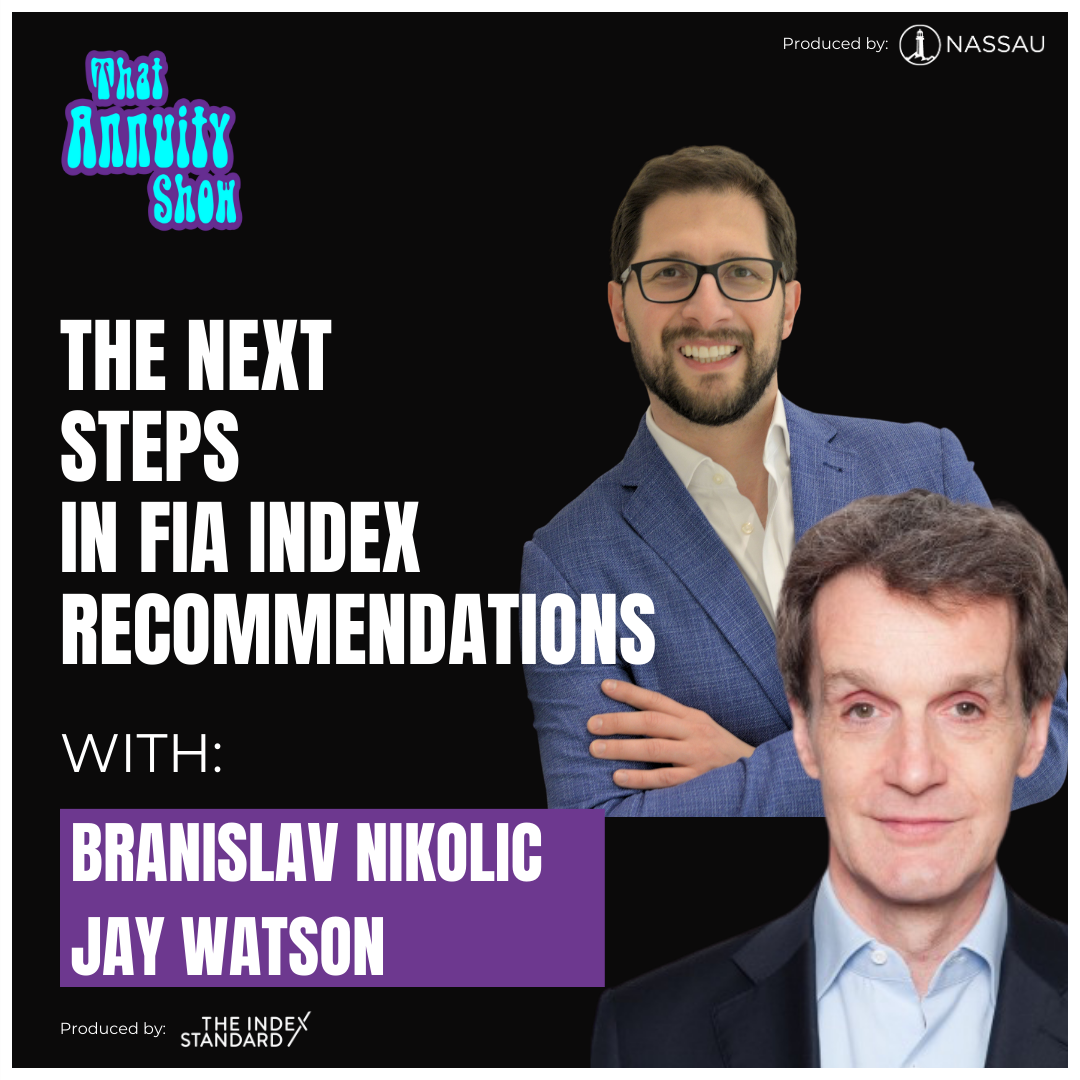In a turbulent economic time, recommending client allocations in FIA indices has never been harder. Our friends at The Index Standard, Branislav Nikolic and Jay Watson join us today to talk about the latest iterations on their rating models.
Links mentioned in the show:
https://www.theindexstandard.com
Listen
Watch
Receive Updates
Show Sponsors
Episode Transcript
The discussion is not meant to provide any legal, tax, or investment advice with respect to the purchase of an insurance product. A comprehensive evaluation of a consumer’s needs and financial situation should always occur in order to help determine if an insurance product may be appropriate for each unique situation.
paul_tyler:
This is Paul Tyler, and welcome to another episode of that annuity show and I’m glad to join everybody back. I safely made it back from Toby in Egypt for a two weeks trip, and in Bruno, I didn’t tell you this before, but I actually found out there was an ancient Egyptian prince who apparently had an annuity way back
bruno_caron:
Uh,
paul_tyler:
in Mesopotamia,
bruno_caron:
uh,
paul_tyler:
and was given almost like a cup on payment every year. But You found some interesting news that we probably should have high lighted earlier around the Nobel Prize in winter. and uh, uh, One more reason why annuities should be looked at by a lot of people.
bruno_caron:
Right, well, not that much of a recent news than the Egyptians having annuities,
paul_tyler:
Yeah,
bruno_caron:
but indeed, indeed, Benbernatki, who won the Noble prize winner, not not that long ago, joined a long list of noble prize winners who at the very least have you know, push forward the concept and the implementation of annuities. So I think that’s a that. That’s another step step forward and step in the right direction.
paul_tyler:
Yeah, he, tsa, How are you Good this morning?
tisa_rabun_marshall:
I’m good this morning. I’m just slow to get off a mute in case there’s you know, some noise distractions,
paul_tyler:
All right?
tisa_rabun_marshall:
but great to be here this morning
paul_tyler:
Okay, well, Ramsey, let’s see. can you connect the dots between Nobel prize winners and Egypt, Shan, nobles, perhaps, and annuities and the topic
ramsey_d_smith:
Well,
paul_tyler:
we’re going to cover today.
ramsey_d_smith:
the only thing I can say is that that at one point my freshmen are sophomore year in college. Ben Bernanki was teaching me beginning beginning economics. I forget it was introductory macro, introductory micro, so always very very happy to see him doing well out in the world, And it’s interesting. So you mentioned that there was an. I think you just mentioned there was an Egyptian Egyptian annuity. My wife handed me in art. All about a perpetual bond owned by Yale, as it happens from Holland, that dates back to the fifteen hundreds. they’re still collecting. Literally, they’re still collecting a handful of uros every year on the back of that. So
paul_tyler:
Uh, uh,
ramsey_d_smith:
the there there a number there, a number of really phenomenal examples. But listen, The most important thing we have going on today is that we are joined by two special people from our lead sponsor. The Index standard. They’ve been our lead sponde For a year now, and for those of you listen to the show and at the beginning I believe we’ve got a. We’ve got a one minute intro. We talk about what they do is they bring clarity to the growing and inherently complex world of industies that are part of the fixindexinuities that so many people that listen to our show are probably involved in selling. So we think it’s a very important service and they are. They’re launching some some new initiative As we speak, and that’s what we’re going to talk about today. So first, I’m gonna introduce Bronislav Nicolitch, who is head of insurance at At Index Standard Brneslov recently joined from from Chanic, Let him talk a little bit about his his new role in his transition and we’re also joined by J. Watson, who is calling from London again. Yet further proof that we are an international show. Ah, and J is head of Analytic at head of Analytic at At Index Standard, and is a long standing colleague of the founder Index Standard, Lawrence Black, who is who is a great friend of the show as well, So With that Branaslove, bring us up to speed. tell us about your latest.
branislav_nikolic:
Thank you, Ramsey, it’s my absolute pleasure to be here. Actually, last time I was in the show was actually my day two or day three after joining the Index standard, So I was really fresh fresh of the boat. So yeah, as you said, like, I’ve joined Fromchanics, where I was leading research and everything that focused about retiring, complaning and anuities, and inclusion of annuities, whether it’s a retail or or in plan, and making making a shift index Standard where I really am looking into index solutions in either of the settings, But it’s insurance. It’s a annuities, index index, life insurance, and starting to look into in plan solutions, they are more and more willing to look and adopt index indexanuities, So a pleasure to be here and looking forward to our chat.
ramsey_d_smith:
J. Tell us a little bit more about yourself. Yeah,
jay_watson:
Thanks for that, my name is J. Watson. I joined the next standard just under two years ago, and prior to that, for best part of two decades, I worked in investment banking. most of that at Barkley’s capital, and most of that time was spent designing the industies that we’re talking about today, so across the different asset classes on a global basis, So based in London. That accounts for my accent, And I’ve known Lawrence for very many years. We were colleagues over the years, and I joined when Lawrence founded the Index standard. I joined him quite soon afterwards, and I’m very happy to be part of our mission, which is to help people better understand these industries and how they can work well for individuals and retires.
ramsey_d_smith:
All right, so why don’t we get into it And by the way, I neglected to acknowledge that, So Bruno is calling from Montreal, and Branaslavis is normally in Toronto. Don’t know where you are today. So Canada is also very important part of our national presence. So Bronaslav, tell us about. Tell us about this this latest initiative that that you’re undertaking with the Index standard.
branislav_nikolic:
So what we have done it in the standard and again, even before I joined. I know what what a core mission was, as Ja said to help teople understand Complex in this is better understand how the impact the insurance solutions, and more important how to impact the retail products to end up in the in the hands of moms and pomps, So what we do is kind of like multimultilayered, so just to kind of remind those who ve heard of us are kind, introduced it to those who haven’t we, For ratings and forecasts for for industies, and with our ratings, we’re trying to show how well designed or how robust. industisare and talk about there. Overall design can bring those in common language, simple to understand, and with a forecast, we are trying to rely on what we call the wisdom of Wall Street, and basically try and see how these are gonna perform Over next next little while, in other words will take, an index will do a v n analysis on it. See how it relates to the capital, malice assumptions that are coming from Um. insurance, big insurance companies, banks as managers, and see how the industries themselves would react Going forward. Now that’s all good. But the main question, the even we’ve been asked was around. How do I apply that in inanuities and we, There was a lot of work. Um, and of trying to figure out what the simplest way. what’s the way that would make sense to to to to mom and pop to my grandma That I always like to bring in in the scenario that she would understand what we are what we are talking about right. So we first wanted to put these index forecast to annuity annuity designs, and see if we can get a forecast or the annuities based on on annuity parameters that are different from different carriers, different surrender periods, and so on, Yet the forecast, or what we call Net forecast credit for for the annuities, But then soon after the question, the question really started started to be be asked is how do I know where to locate my money with inane, So we understand that these industries themselves are like many portfolios that are highly optimized to react to different market events, Um target different levels of volatility. But now that I have many of these many portfolios and many of the creating strategies with, In a new, How do I locate within the annuity and how do I word redundancies? A lot of people were saying that they are seeing either binary locations to it, say five hundred cab strategy Or if there are multiple options, they would say have five options. I split fy ways. You have three options out three ways. And what we wanted to bring some rigor is how do you? How do you do that methodically, But then still keep it. Keep it simple enough. so so so people, Or at the receiving end of this can get something. Something out of it
bruno_caron:
So if you take it, you know from from from to your point, from you your grandmother’s perspective. Now, let’s start with the first step induces. if I’m presented as a consumer between two different induces, what would be the differentiating factor between your gold rating and your neutral rating? Like, What are those those differentiating factors between those, those particular rating of those those induces.
jay_watson:
Okay, I’ll try and answer this, Bruno. The first thing to say is that our rating system is entirely analytical, Is no subjectivity. It’s objective, so we look at a very large number of different aspects of the index design its performance. It’s the way it’s desined, How many parameters it uses what underlings. It has, a very, very large number of considerations On Consideration we score. We then add up that score to get a grand total score for a particular index, and then once we’ve got that number and number out of a hundred, we compare it with all of the similar induces, So for example, the dividend index we compare with another dividend index or a multi asset index, We compare with another multiaset, a set of multi acid indusies, So we compare like with like apples with apples. So there’s an analytic score And then with that Score we compare that score with the other similar indusies, and then we produce we bucket those scores. The top ones get platinum, the next group get gold, and so on, and so on. So it’s an analytical process that takes into account a great many different aspects of the index design. And then we rate that index versus
paul_tyler:
How does
jay_watson:
it pears.
paul_tyler:
the how does time factor into your analysis and particularly my time? You know, if I plan to retire, Say twenty years from now versus ten years. Uh, one index may be gold, I would presume and please tell me this. I would think one index maybe goal, because it consistently returns a sort of narrow range of fairly good outcomes or has in the past, and we project it for Or another, one may actually produce some really incredible outcomes if you look over a period of say ten years, but if we start to narrow down that range of time and say well, Paul, you know, you might be starting to think about retirement sooner rather than later. I’m taking a little bit of a risk that I’m not going to get appear at a time where this particular industry has generated very high returns.
jay_watson:
That’s a very good question. We don’t have a crystal ball we’d love to have, but we don’t. What we’re trying to do with our index ratings is figure out which industries are well engineered and therefore more likely to do well over the long term, versus those of perhaps less well engineered that may look good in their back testing phase when they were designed, but may perform less well to the future And they go live. So that’s the first thing. It’s not a crystal ball, but it’s a A figure of measure of quality. The second thing is to say we always advocate this and it’s nothing new. Diversification Very simply, do not put all of your eggs in one basket. There are great many industries out there that I’m happy to say are very well designed these days, but even so it makes sense to diversify so there are some industries that may have a hard time in certain environments. Many industries have had a hard time in the last year, with both equities and bonds selling off a very unusual circumstance, so it’s very difficult to. It’s almost impossible to predict what’s going to happen in the future. The best thing you can do is to be diversified Now, that’s exactly the approach that we advocate in our model applications for the fixing, fixed indexed annuities. There are many now that offer multiple In This is, and at first sight, that becomes bewildering. I can imagine if I shown this to my mother, Bless her, she would say, I simply, I’ve never heard of most of these industries. Yes and yes, the Blomberg aggregate. Yes, the rest know, so people are stuck Th. they’re presented with often very good choices, but don’t have an informed viewpoint on what to do. So that’s where we aim to help.
ramsey_d_smith:
So I would just this comment that that one of the toughest things we do in the world of industies is actually really truly understand. You know, when things are redundant and not, it’s really very difficult to do without looking under the hood. One of the examples I remember from my old days was Ou know. there’s the S. P. five hundred, And then there was the five hundred value index and there was the five hundred growth index. Five hundred has five hundred ish stocks, It. but each of those industies had three hundred and some odd stocks in each. So if you added them together, it didn’t actually equal the five hundred, because there are a lot of stocks that were actually in both industies. Right So you know that’s why. Now that is precisely why know the work that you’re doing is so important. Because it’s really. It’s really hard to do that without without really being able to look under the hood. So Brontaslav wanted to get your thoughts on on Or get get your insights on on some of the tools you use. So we, we had a. We had a discussion off line where we talked a little bit about different thoughts and some of the analytical tools that are used in this in this space, Monte Carlo, being one of them. So maybe tell us a little bit about sort of the tools you use to do this work, this important work. and and maybe what, some of the pros and cons are that emerging in the intellectual debate in the financial services industry?
branislav_nikolic:
Would be glad to Hanks for that. So so I
ramsey_d_smith:
Yeah,
branislav_nikolic:
think that the ties to pulls pulls question as well into What happens if we want to retire in five years? What it will happen if you want to retire in ten fifteen? You got to have the way to test this out. So you know little framework that exists that has been In question over over last last one or two of your episode was Is Monte Carlo a good approach, and I’ll go straight to say that like all models are wrong, some are useful and there are tools that can do certain things, or tools that can not do certain things, but we waste the test. So the question that Paul asked is like What if I want to can retire in five or just ten years? I think our general approach to forecasting is that you have to take a long term view, because the capital of market assumptions Coming from investment banks or asset managers are ten year capital market assumptions. So if you do our d n analysis and an index apply capital markets assumptions to it, you get ten year forecast for an index. So it’s important to understand that this is not Co. Index will do tomorrow six months from now, two years from now. That this is a relatively long view on an index. Part of what goes into into our process is simulating the out, Basically taking the capital of market assumptions allying than with our, with our index in the d, n A. and kind of seeing what what a future holds. now, I would think that that’s appropriate and good use of simulation framework. I think more importantly is how you present your results. I think that every every and any tool is very dangerous. It could become very dangerous if you either unknowingly or got for deliberately misrepresent Results out of a two. or, or, even if you, if you as a user don’t understand, Um, So so the analogy that what? what you’re referring to, couple of episodes back was that what came out on Lee linked in was. Oh, let’s ban Monte Carlo, you, Ben Monte Carlo. Like three quarters of finance will help Um next day, and people say you, while like
ramsey_d_smith:
Hm,
branislav_nikolic:
this worked for a long time, worked in so many contexts that it’s working very well. Now there is that there’s the aspect where we say Oh advice. There’s usually use these to convey the message. Advisors misinterpret the results. And to me that’s like saying car is a bad idea because you give car to my toddler. Oh, that can be dangerous, but it’s very useful otherwise so so that’s that’s That’s where here we stand. So what we do is we take capital market assumptions from the market, what we call the wisdom of the Wall Street. We apply this to the set of analytical tools to identify Um. exposures of the industries, then simulate based on a couple of market assumptions and those exposures to get the index forecast, and the lastly, we have to what was saying, fully algorithmic way of locating within within anuitysbasically, using the results in a proper way to come up with the with starting locations for for these products,
jay_watson:
If I can just jump in here. It’s perhaps worth saying that
branislav_nikolic:
M,
jay_watson:
we’ve been producing these raw forecasts for industies for a couple of years now, and people in general very interested in them, as as a counter to simply looking backwards. It’s always interesting to look at history to have a field for things, but we try and look forward as well, and that’s what our forecast do for industries. But what we found was people who say. Yeah, Well, Great, but what’s it going to do when it’s in an index when it’s in an annuity, when it’s in a crediting strategy, and in particular people we spoke to clients, and they say, Look, I’m being presented. My clients are being presented with a choice of forty percent of the s. n P over a year or a hundred and seventy five percent participation in this bank index. I’ve never heard of How do I choose How where do I start? So what we did builds on what brands Lave explained. We took our role index forecasts, and we simulate what an index will do in a particular crediting strategy. So we take into account the participation
branislav_nikolic:
M
jay_watson:
we take into account fees. we take into account the crediting frequency, et cetera, et Cetera, All of the aspects that are required, we account for all of those on We, And a simulation out over ten years. When this goes back to Paul’s question, to try and get a field, an understanding of what a given crediting strategy might do, and the results are very striking. There’s a big variation in the results depending on the industies depending on the crediting strategies. So this is, we think this is very useful information, and it’s the basis Of these are our forecast, net forecast credits, and we use that, as Brandes pointed out, as the basis for our model applications, among those crediting strategies
paul_tyler:
Yeah, it’s
jay_watson:
in a
paul_tyler:
up.
jay_watson:
given
branislav_nikolic:
And
jay_watson:
F.
branislav_nikolic:
Ramsey,
jay_watson:
A
branislav_nikolic:
one thing,
ramsey_d_smith:
Go ahead on left.
branislav_nikolic:
Ramsey, One thing that you, you asked and I think it’s worth mentioning here is that we are the guardians of assumptions, so we believe that among us, we have enough experience and hand book know how to keep the assumptions in check, so that they are aligned perfectly, and when we get a capital market assumptions, we don’t take it from a single source. We take it from over fifty sources, and we then come up with our own that can reflect, Um. all of those. So the variation there, we try to smooth it out again when we apply it into into into our process. The other one is that we use the results of Let’s a simulations. In one step. We don’t say. Oh, this is going to be a single number. We provide distributions of results, we pick out moderate, conservative and strong, and we present all the data. So I think it’s also important to talk about what goes into the model, what comes out of the model and how Interpreted. and we, Our model location says what I referred to as an ultimate Che, Cheat on how to use a fixed indexcenuity You see that All you see how you locate, you see what industries are. You see how this is rated. You see what expected forecasted performance of the industries in the raw form ice, as well as through the through the annuity land, or of Crete strategy lands. So you have a full story to tell. How does hundred seventy five percent Partipation, Or nowadays, numbers that are like in two, three or four hundred, there are starting to sound like very odd to again, some one like my gramma. You ould say. Oh, you’ll get three times the performance of an index. Are you sure you can do that for me? Like that sounds fishy. I’ll go with a one that gives me up to a hundred percent. So all of that and mix together presented in a clear and concise way is what E are what we are advocating for. So at the end and consumer and user has has a Chan, So of a better outcome,
tisa_rabun_marshall:
A question. Congratulations on Un launching the ratings, but I have a question on design. Even behind the scenes, I sit in a marketing seat, so I imagine there’s several hours sitting in a room, brain storming and thinking through what you rolled out the decisions around are. The psychology may be around six levels versus eight or six levels versus three ratings, and sort of using medals versus some other reference to good Our best. I’m just curious. some of the discussion may have had there, and my follow up question to that is you know, how do you get the consumer who is already skeptical to pick anything other than platinum or if something moved from watch to gold? Like, how do you make them feel like? Yeah, this is actually going to you know, be beneficial to you. It’s like it’s if it’s watch. it’s always watched forever. In all ways, I’m never going to trust that it moved up. Just really curious. Some of the psychology as you thought through the ratings in and on the scale.
jay_watson:
Okay. That’s a great question. You are absolutely right. We did scratch our heads for a long time on this and we came up with our rating Platinum, gold, silver, copper, Neutral, and watch. We wanted something that immediately conveyed better or less good. We thought about lots of different possibilities. Stars. somebody suggested dollar signs. We thought that was not a good idea. What we wanted to convey was a sense of quality in a very simple way, So I don’t know whether we’ve got that right, but we’re going to stick with it. The other question you ask about. should someone only ever choose platinum? The answer that is, no, broadly speaking, the top three or four of our six categories. They’re all. They’re all good, But the platinum we think is the best, All of the platinum gold Silver. Those are all really well engineered industries, so you should be confident with any of those, and in particular those ratings they do move around through time of an index Is Platinum doesn’t necessarily stay platinum forever. We take into account in the the analysis of that score, that rating we take into account the Forecast performance of the index. Also, it’s live performance compared to its back tested performance. So as an index become live for a longer and longer, we give more weight to that live performance. If that’s good, then that will have a greater waiting. So if an index is rated silver, say it may go up. so the ratings do change not very much, their broadly sta, But they do change from month to month, But they do not lurch from platinum
ramsey_d_smith:
M.
jay_watson:
down to watch back up to gold again. there was no yo oing around. We were were confident when we designed the scoring structure that it would be stable, but it would move gently over time if I appropriate.
tisa_rabun_marshall:
Thanks,
paul_tyler:
I do think communicating potential outcomes is incredible, incredibly complicated. Love. the idea of an icon, M. now, I think of how we show ranges of outcomes today and it’s it’s difficult. I think our illustrations to you, so I think we show um, best, worst and last, and ironically, the last can actually be better than the best. The way the illustration rules work, and try to explain that to six year old consumer. Another one way we’ve we’ve looked at this, you know, brown, love, I think I’ve shared some of this work with you. We’ve looked at distribution outcomes. Now we’ve been doing this, you know, In a mirror looking backwards, and you start becatsome. Very interesting results. Some of these industies generate. You’re thinking of distribute normal distribution, cure very wide tails, Some very high peaks, So I’m sure there are many many covets, But you know all things being equal, you have an index. The goal of our of any type of guide is should be in my mind to help a sixty year old achieve safely achieve their retirement objective. Suppose we have fund A, that say shows, or projects that will generate, on average, say six percent return, And M with a standard deviation of say one or two per cent, so low, but very tight curve of outcomes, and we have almost same exact industy with averages nine percent, But the standard deviation is wider, meaning the chances of going you know lower than that more conservative fund is it could happen which which one gets the platinum, which one gets gold. Or have I just total Trashed your and walked over your model?
branislav_nikolic:
So you open, you opened two very important questions.
jay_watson:
Should I answer
branislav_nikolic:
I
jay_watson:
that,
branislav_nikolic:
think I think you should the last one, but I think you opened the very very very two very important questions. One is about the sales practices and illustration practices which we can get into you can get into, and the other one is Um, What’s what’s the preference? You started talking like means and stoundedeviations, And I did some that I in my schooling, But the key here is that My grandma doesn’t doesn’t understand a single word that you just said, So I think what what may work for for some one like her is like, Are you preferring index that’s hitting singles and doubles in baseball terms, or you’re looking for someone who is hitting home runs and which you prefer? It’s your thing. On average. they’re going to have the same number of rounds in the season to take a long term, So that’s the first thing, But the other one is that you mentioned illustration practices and impassionate about this one. It’s that I think they are. They’re kind of product of their time. If you go back to an n I cereals came about. It was like in early twenty tents, which just about two thousand eight. and I think that the last really meant to show. If two thousand eight happened, What what would the out can be? Now you? You move that rolling window away from two thousand eight, and last really becomes that you’re looking into the raging blue market hat we’ve seen. Now you’re starting To see a little bit of twenty, twenty, twenty or twenty twenty two coming in, but over all like eight out of out of those ten years are still phenomenal, so I think those are due to be to be adjusted to kind of prevent. what what I think is. It’s cheating that something that was meant to do a good thing include a widely bad outcome in those illustrations. Now in its place you are seeing the best possible thing that can happen to you. So so then and then, the third question that you asked is about How does the performance impact our rating, So I’ll go ahead and ask ask J to to give you give you the explanation there, Because that’s basically a difference between ratings and forecasts.
jay_watson:
Yeah, the answer Paul is, we do take into account our forecasts, but it’s only one of the things we look at. We’re not just looking for the index with the highest forecast. Put all your eggs in that basket. That’s not the approach we advocate. As I say, we’re trying to give an appraisal of how well engineered an index is how well how robust it is. Is it likely or less likely to do what it’s supposed to do? That’s what we’re looking for. And so to your question, Should somebody choose six percent return expected return with a vol of one and a half? By the way, that would be if you could find that index. Tell me, that’s amazing versus nine per cent with a Vol. Can’t remember what higher it depends. Is the preference. as brands said, it’s the preference of the end investor and that’s where the advisors come in in helping those end clients make a decision. Do you happy with singles? Oh, you’re happy with nothing. Nothing and then maybe the occasional home run. it’s up to the client. So our role as we see it is to try and put in front of people that information to help them make an informed choice. Help guide their own clients to what is most appropriate for
branislav_nikolic:
So
jay_watson:
those
branislav_nikolic:
is
jay_watson:
clients.
branislav_nikolic:
it fair if if I simplify it may be the other way that, if you’re look into our ratings, that will tell you that will describe the index. It would take everything that the index has to offer into consideration, and it would can tell you whether the index keeps its promise. In other words, whether the design that showed very well in design phase, or back to days carried into the future. Whether the mechanism works as described, How are the metrics coming out for for for Next mechanism? And then you combine that with a forecast, But you then can compare the forward looking view on how the index would perform, and you would say ideally you would pick like metal index, platinum, gold or silver, with a very stable return profile in the forecast, that doesn’t deviate much between conservative, moderate or strong, and then you look into even into the past, and say that now, last end Years or last twenty years, this index was returning five or six per cent. For we’re looking. we see somewhere between four and seven. That means that that’s indicative of what might might might have happened, but I think that’s that’s kind of. that’s harder to gage once you get into into the annuity and I think this is the last piece. and this. I was hoping that that was your question. Like how much you working of spending in the room, thinking about how to simplify the location with an annuity and how do you present those Results? So maybe maybe we want to talk. Talk about that for for for a second, And then do you want to want to lead it off, or do you want me just to say that again? The idea was there to make it simple. Make it. I’ll go it mic again, so there is no. there is no secret sauce in it. Everything is there. everything is disclosed and we want to give the option, especially in today’s hot higher than than what we’ve seen of our last year’s interest or environment given to F. A. There still fixed anuities. How much of above and beyond the fixed rates are these strategies bringing to the table? And should you consider the fixed rate that it’s now short history, but historically high. And what not? Do you want to maybe talk? Talk about the process for a little bit.
jay_watson:
Yeah, sure, thanks. have so again, we’re acutely aware that people are presented with a long list of choices which re going to be very difficult to understand these strange terms on unusual indusyes, strange indusies. What we do for every single crediting strategy is calculate the expected returns of that crediting strategy, So in fact, we calculate the moderate, and also conservative and a strong number, sort of weaker the expected value, and then a good scenario. We do that for each index, Each crediting strategy linked to each index. That’s the first step and it’s a big effort. So there might be five, six, there might be twenty different crediting strategies across three or five. in. She is. For each index we pick out the crediting strategy with the highest expected return. This is the selection part of the process, So for each index, look at the crediting strategy linked to it and pick the one with the highest expected return. Next step Check is that higher than the fixed rate? It jolly well ought to be, Because if it’s not higher than the fixed rate, why would you Take the risk of allocating to an index which the expected return is less than the fixed rate, So it’s less than the fixed rate. We throw it away, we discard it. We also discard an index of the best of its crediting strategies. The expected return is substantially less than the best available in that F. A. So there’s a big selection process. We try and sort out the wheat from the chaff You like. Once we made that selection, we then have two possible model applications. We propose. Both of them are fundamentally simple and both of them are based on the idea of diversification. So having made that selection in our first model, we just allocate equally to each of those selected industries. very very simple. The other model is a little bit more sophisticated. We tilt The locations according to the forecast. The expected returns are forecast for those crediting strategies. And so if the forecast, the expected return is higher, we give it more weight. If it’s less, we give it less weight. So you’re taking a little bit of a view according to the expected returns, But in both cases the selection is the same. The selection is looking to pick out for each index, the crediting strategies, which over the long Term, we think calculations show, demonstrate indicate will produce the highest returns over the long term.
bruno_caron:
Yes,
jay_watson:
Does that make
bruno_caron:
absolutely.
jay_watson:
sense? Everyone?
bruno_caron:
And it’s a very complex approach obviously to to help again to take Bronslab’s grandma and everybody else out there. Of course, you touched on diversification significantly earlier on. How is diversification achieved in the context of what you just said, Like having that algoritam picking and choosing different. You know, comparing
jay_watson:
Sure,
bruno_caron:
The the the expected return, Um. How is diversification achieved through this this process?
jay_watson:
Okay, Well, let me let me express it a different way. What we don’t do. You might be tempted if you have the for every crediting strategy of the expected return. Say Ha, there’s the highest one. Let’s put everything in that We don’t think that’s sensible. What we do is for each index we allocate where we check that the crediting the best crediting strategy for that index is not below the fixed rate or not too low. And then, if assuming that’s okay, then it gets an allocation. That’s the diversification we allocate to all of the industries where the crediting strategies are good to very good.
ramsey_d_smith:
So my comment? So Bruno? Actually? Did you have another follow one there before I jump in. Just going to say Bruno. Yes, it is it is. It is a complex process, but it’s also a a complex problem right, so industys, even simple induses have complexity, some of which I alluded to before. and then you know, many of the industries that are in in this space are even more complex because they’ve got lots of different rules and they’ve got Utility controls and lots of things like that. And so then there’s a. There’s a process valuating them at that level, And then you put them on to A and do an f. I a chasse. and suddenly you have all these right symmetries that are brought in because you’ve got you’ve got caps and things, so, I mean, I don’t know how one could actually sort of see fit to be able to optimize any of this without a very strong quantitative model, Which kind of brings us back to where we were with Ronesla earlier. Right
branislav_nikolic:
Oh,
ramsey_d_smith:
is at the end of the day you need a model, right, you need a model, and then, to the extent that you have a model, It, really, the discussion comes down to how robust are your in puts in your methodology, And so right, This whole discussion is really about like you know, you are describing the care that you put into those two critical elements to using this right. this sort of widely. Why The accepted way of evaluating evaluating the economic opportunity? So anyway, that’s that’s my. That’s
branislav_nikolic:
Oh,
paul_tyler:
Yeah,
ramsey_d_smith:
my twenty five cent summary. But did I did? I miss anything there, Bones love.
branislav_nikolic:
I think I think you get it. Get it right on and then Bruno, just to try to answer your question, Because again, I think the question that you ask like sounded simple, but I hear it as a very deep consequences. so one thing is that we try to read out redundancies in terms of strategies on the same index, because again those could be redundant. those could be all waiting. So for example, if you have an index and you have two strategies that perform the best You could say, Oh, give me half of one half of the other. You did not diversify. You just chose to different pay out structures on the same index. So that’s the first step how diversification comes into play. but we also rely on on diversification. Is that the carriers, when they are putting these in the sin like they are usually not redundant. So you, you wouldn’t have industries that are kind of carbon copy replica of one another with within the annuity, and the third one is diversity Cation. With respect to the fixed rate, a fixed rate is favorable compared to to those well performing strategies. So that kind of is kind of on a three levels of the versification that the dis offers Now, Could you could you go? Could you go deeper? Could you try to optimize? use use term that that Ramsey brought up like optimize? How can you optimize this? I think when you say optimize, people Go to mark of it. and like Moltiporfolio theory, and mean variant optimization, and the key with it a fixed in dexcnuities that allows us to be a little bit simpler to use a ittle bit more of a curistic approach. If if you want to call it is that you cannot lose money, these are principal protected product and you can really look into what’s the difference in my upside. Now you want to do this for, let’s say registered index annuities that you can lose the money. You definitely have to start measuring the downside and compare upside and downside and desk. This would kind of add you another level of the versification. Do you want to go for strategies? We can win big, but lose big occasionally, or you want go for a more stable stable return. So I think you’re asking a very deep question we’re trying to in a context of fixing eccenuities. answer it with a very simple solution. But there is a lot of lot of things that are going back on,
paul_tyler:
You know, this is a real problem,
jay_watson:
Ah,
paul_tyler:
our business that you are all solving, you know, and we’ve been a conferences. I’ve talked to Im. as we’ve talked some more top agents, and in selection is a very important issue. I think that really could benefit from. you know more support in the industry with the tools like yours. Um, I think last year You know the combination of bonds being down with stocks really heard a lot of these low vall induces, and I think the nejercoraction as I’ve heard from some agents is, I’m just going to put everything on the S and P five hundred, but that’s not the right solution for your clients. Necessarily
branislav_nikolic:
But you, sorry, I had to had to jump in you. you’re You’re saying two things you’re saying Control Industries didn’t work well last year, but going forward I’m going to put him into
paul_tyler:
Exactly.
branislav_nikolic:
how S impeded last year
paul_tyler:
I know Vranslavthere’s
branislav_nikolic:
Like these industries did a bit better than M. P,
paul_tyler:
Right
branislav_nikolic:
So
paul_tyler:
in going back. Going back to Ramsey’s point. We need structure around this
branislav_nikolic:
M,
paul_tyler:
and this is not a.
branislav_nikolic:
M,
paul_tyler:
You know, we’re not trying to time the market inside fix into exinuities. Nor should we. we need you know. J. that perspective look that encourages you know behavior that that creates outcomes that the products or designed to design to deliver. So I know we’ve got a lot more we can talk about Ramsey. Lot more more at the top of the hour. Um, you know, tis a. Do you you have any like last thoughts or comments on this topic?
tisa_rabun_marshall:
I mean, I think we all agree it’s complex, right and so I think this this rating system To de mystify it, break it down. make it simpler. So it’s interesting to hear you know some of the thoughts that went into building it, and um, I think I think it’s a step in the right direction, right to help
paul_tyler:
Yeah,
tisa_rabun_marshall:
the industry
bruno_caron:
Yeah,
tisa_rabun_marshall:
and to help the end consumer understand or make a decision in a different way,
paul_tyler:
Oh, an, I’d like to see our somer products and see the radiance you have here,
tisa_rabun_marshall:
Yeah.
paul_tyler:
Bruno, you, your last thoughts,
bruno_caron:
Well, I certainly applaud the indevor and the the initiative. I know I was in similar similar position not that long ago. and when things are going well and platinum and gold continued to be platinum and gold, you don’t necessarily get the metal. But when the boat starts rocking, then that’s when you get the tough question. So it’s It’s a tough. It’s a very difficult challenge and at the risk of stating the obvious, I know Complex environment, So yeah, I applaud the initiative well done,
paul_tyler:
Um, Ramsey,
branislav_nikolic:
Thank
paul_tyler:
bring
branislav_nikolic:
you.
paul_tyler:
us home.
ramsey_d_smith:
So
jay_watson:
Yeah,
ramsey_d_smith:
thanks again to Bronnaslav and J for being here. Hopefully, I should have pre summarized my my thoughts earlier. and so I think that your your question earlier about marketing this, and in the way it’s communicated super important. There’s everything about this. this, this challenge and opportunity is, it requires a lot of thought, everything from it, the quantitative progression to how we ate, He, and communicating it to the channel. So thanks to everybody for for another great episode, and thanks to the index standard for being such a great sponsor and friend of the show for the last year,
paul_tyler:
Yeah,
ramsey_d_smith:
Yeah.
paul_tyler:
hey, thank you all and
jay_watson:
It’s a pleasure,
paul_tyler:
once again thank
jay_watson:
thank
paul_tyler:
our
jay_watson:
you.
paul_tyler:
listeners. Listen. send us feed back. Call us. I get text. I get calls. I know everyone else does, and give us your opinions
bruno_caron:
M.
paul_tyler:
and we. we’ll continue this. the discussion, this topic. I think it’s really important for our business
bruno_caron:
M.
paul_tyler:
and join us kin next week for another episode of that annuity show.
 That Annuity Show
That Annuity Show
























Recent Comments